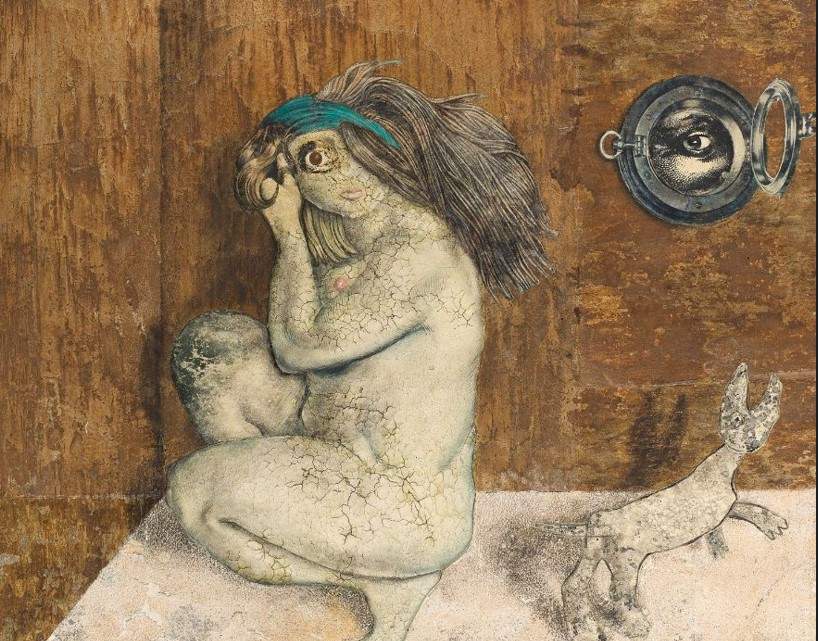On the occasion of the anniversary of his 99th birthday, the Ferrara Arte Foundation and the Art Museum Service of the City of Ferrara are dedicating a major exhibition to Carlo Guarienti (Trieste, 1923), an original protagonist of the national and European art scene for more than half a century. The brainchild of Vittorio Sgarbi, the retrospective exhibition La realtà del sogno, set up in the rooms of the Castello Estense from October 29, 2022 to January 22, 2023, presents to the public more than one hundred works, including paintings and sculptures selected by Pietro Di Natale, Vasilij Gusella and Stefano Sbarbaro, through which the artist’s wide-ranging and articulated path, marked by a constant, as much as coherent, process of metamorphosis, is investigated.
Born in Treviso in 1923, Carlo Guarienti studied medicine at the University of Padua, where he graduated in 1949. Meanwhile, between 1944 and 1945, called to arms, he worked as a preparator of artistic anatomy at the Academy of Fine Arts in Florence. Returning to his hometown in 1946, he made still lifes, portraits and the most significant work of his early activity, the San Girolamo, exhibited the following year at the Modern Painters of Reality exhibition organized at the Galleria de L’Illustrazione Italiana in Milan by Gregorio Sciltian, Pietro Annigoni, and Antonio and Xavier Bueno, signatories of the group’s manifesto, which stands in open conflict withabstract and informalart.
After this debut, in the wake of a restless realism anchored in the tradition of the Quattrocento Padano, Guarienti embarked on an autonomous path, which initially veered in the direction of a fantastical and visionary language, evidenced by a work such as Birth of a Still Life (1956). In the 1960s he experimented with a technique borrowed from the tearing of frescoes and based on the use of peeling plaster, cracks, collage and a synthetic resin mixed with color and sand. Later, after developing a surrealist bestiary inspired by Max Ernst and Aloys Z ö tl, he becomes a painter of mental geometries, of pure, two-dimensional or solid forms organized in rigorous perspective spaces. The figure is supplanted by lines, numbers, street signs, perhaps as a nod to Pop Art and thus to the contemporary. Since the 1980s he has painted numerous still lifes, set up in suspended atmospheres, between reality and unreality, between consistency and transparency, a mode of expression also adopted in the genres of self-portrait and view, addressed in the works of the following years.
“In his works,” Vittorio Sgarbi pointed out, “ we find what metaphysical painting had wanted to represent, from its beginnings, with de Chirico’s research: an essential dimension, totally purified, of pure thought, which comes to distill and thus to distance emotionality. Purely mental painting.”
A die-hard experimenter, Guarienti also expresses his complex poetics in his plastic production, where he pursues a powerful formal synthesis, between archaic models (Etruscan and Greco-Roman i) and twentieth-century suggestions (from Giacometti to Marino Marini), and in the art of engraving. Tempted by innumerable stimuli, Guarienti points in his work in the direction of a realism based on thought, on abstract concepts that translate into images, more or less enigmatic, suspended between dream and reality.
Information and ticket office 0532 419180 castelloestense@comune.fe.it | www.castelloestense.it Reservations https:// www.comune.fe.it/prenotazionemusei
 |
| Ferrara, the reality of Carlo Guarienti's dream on display in the halls of the Castello Estense |
Warning: the translation into English of the original Italian article was created using automatic tools. We undertake to review all articles, but we do not guarantee the total absence of inaccuracies in the translation due to the program. You can find the original by clicking on the ITA button. If you find any mistake,please contact us.